Medgyes
Medgyes (Mediaș, Mediasch, Medwisch, or Medwesch) is in Transylvania, Romania. It is located on the banks of the Nagy Küküllő River, and it is 56 km from Nagyszeben (Sibiu) to the northeast. The name of the city comes from the Hungarian word “meggy” (sour cherry). Before the German Saxon settlers arrived, Hungarian Székely people had lived in this area, they were from the Medgyes Clan. The Romanian name originates in the German version, which also comes from the Hungarian name (Medgyes).

In this article, let me give you the historical chronology of Medgyes, compiled by M. Szabó Attila. It is most interesting to follow how the history of this town was changing year by year. Please, note, that I use the Oriental name order for Hungarians where family names come first.

It was King Saint László of Hungary who settled the Székely people on the bank of the Nagy Küküllő River in 1075, it was how they found their home in Medgyes. Gradually, they were placed in the eastern frontier region of Transylvania in the 12th century by King Géza (1130-1161). You can find it on the map here:
https://www.google.com/maps/d/edit?mid=1Ao2OxXIrmW_S5ny9phYw8oL_mONmz3Y&usp=sharing

According to Paul Niedermayer, Medgyes was founded in 1046 when the Saxons took over the Székely settlement. The earliest name of the place appeared in a document issued in 1267, it was written as “Mediesy”. The settlement was owned by Jula Magnus in the first part of the 13th century. According to a document from 1283, Bishop Petrus of Transylvania demanded 40 Marks weight of silver from the 8 villages belonging to the Chapter of Medgyes. The place was written as “Medjes” at that time.

In 1289, it appears in the form “terra Medies”. In 1315, King Károly Róbert of Hungary extends the rights of the province of Szeben to the Saxon inhabitants of “Medyes”, “Selk” and “Berethalm”. Communitas Saxonum de Medgyes, de Selk, de Berethalm et de ad easdem pertinentibus. Two years later appeared the market of the settlement in documents.

The Medgyes and Selyk Saxons are granted privileges in 1318, exempting them from going to war and from the obligation to house soldiers. Taxation and justice were administered in accordance with the customs of the Szeben. For the first time, the Seat of Medgyes is mentioned as an administrative unit. The existence of a Saxon “geréb” (an official leader) in Medgyes was mentioned in 1320. The oldest original charter of the judge of the “terra Medyesch” was issued in 1356. The town of Medgyes was mentioned three years later as “Civitas Megyes”.

In 1402, the Hungarian King Zsigmond of Luxembourg (1387-1437) releases the Saxons of the Medgyes-Selyk Seat from the jurisdiction of the Székely Comes. Thus, the Two Seats became independent but their name “Two Seats” appeared first in writing in 1411. The Franciscans built the church and the monastery in 1410.

The first mention of St Margaret’s church and the town notary public appeared in 1414. The mention of the main square of the town was: “in foro Medyes”. The text of the next year’s charter mentions the town judge as well.

In a charter of King Zsigmond of Luxembourg in 1424, Medgyes is mentioned as a civitas for the first time. The town is granted the right to hold two national fairs, a right confirmed in 1498. After 1530, a market hall was built on the town’s market square (now the Main Square). Medgyes was growing rapidly and became a wealthy place: a good target for a raid. And verily, there was a Turkish attack led by Bey Mezid in 1438 which destroyed Medgyes and the Two Seats.

However, life was returning soon. Franciscans (observant monks) settled in the town in 1444. The exact date of the monastery’s construction is not known, but it was probably built in the 15th century. Their church was built after 1500. On the other hand, the church of St. Margaret of the Benedictine Order was mentioned in a document as “beatae Margarethae virginis et martyris in oppido Medjes” in 1447. Its construction was completed in 1482.

The first known seal of the city was created in 1448, its inscription was “sigillum oppidi Medies 1448”. The first mention of the castle and fortress of Medgyes appeared n 1452. The local tailors’ and broad-cloth makers’ guilds were first mentioned in 1457.

Two years later, a Transylvanian Diet was held in the town. It indicated its significance. Also, King Matthias Corvinus was a guest in Medgyes between 9 and 12 December 1462. He returned in 1467 for a few days, too. Matthias must have liked Medgyes because, in a letter that was issued in Buda in 1471, he defended the Medgyes cobbler against foreign cobbler and currier masters, forbidding the latter to unload their goods, except for national fairs.

Strange enough, the first stone house in the city was built in 1475. The next year, Medgyes gained the rank of a market town (oppidum). According to the order of King Matthias, the infamous Vlad Ţepeş was kept in captivity in Medgyes, he was closed into the Mária Tower. We have data from 1477, it says the town had to send 32 men to the army of King Matthias in case of war while the rest of the inhabitants were obliged to stay at home and defend the fortifications of the city. However, Matthias ordered the construction of the town’s walls only nine years later.
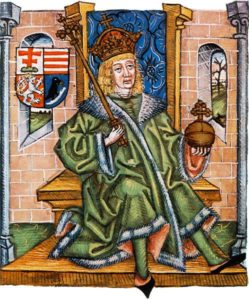
The tailors’ guild was founded in 1483, and the hospital of the town was first mentioned in 1487. The building of the walls of Medgyes began in 1490. It was completed only in 1534, its total length was 2,360 meters, and its height was 7 meters. The width was 80 cm in general. Now, there are 1,845 meters of the walls are still standing.

The Guild of the Furriers was established in 1493. The next year, King Ulászló II appointed a royal judge in Medgyes who was also in charge of this office in Nagyselyk until the walls of Medgyes were not completed. It was also the time when the Guild of the Goldsmith was founded.

Medgyes was mentioned as a “civitas” in 1495. Five years later, the foundation of the Roman Catholic church was laid. In 1501, there were six registered guilds in the town. The next guild was the ropemakers’, which appeared in 1506.
The first mention of the Margaret Day parade (national fair) appeared in 1507, it was written as “Medwischer Margarethi”. It coincided with the beginning of the construction of the Kő-Street gate tower. At that time, there was a Franciscan monastery with 28 cells and a refectory (dining room).

In 1508, the town magistrate was Antonius Faber, the master blacksmith. Mathias Muschnay was the town landlord, a role he held again in 1514. It was the time when they first mentioned the church tower and its overseer. In 1509, Johannes Appessdorfer was elected as a magistrate. Sigmundus, a master tailor was listed as a member of the town council.

In 1510, there were 300 citizens, 38 penniless peasants and settlers, 2 shepherds, and 4 poor people, all about 1720 souls. The Franciscan convent and church were decorated in all their splendor in 1516. King Lajos II (Louis) confirmed the town as a civitas in 1517. It was the year of the formation of the weavers’ guild.

The last Roman Catholic priest of the Medgyes Saxons lived in 1521, he was Johannes, Artium Magister, Plebanus Parochialis Ecclesiae b. Margarethae Virginis in Civitate Medgyes. The guild of the barrel makers was founded in 1525. Between 1526 and 1998, the town was flooded 53 times in 472 years by the waters of the Nagy Küküllő River.

In 1529, Kun Kocsárd, the leader of King Szapolyai János besieged the town, and in 1530 he took Medgyes. In 1530, the height of the tower of the castle church was increased, giving it its present shape. The top of the tower was topped with a gilded sphere. The tower was raised to a height of 68.5 meters.

King Szapolyai gave a privilege in 1534, according to which the sale of foreign goods was strictly forbidden in Medgyes, except for the annual fairs. At the request of the town, the king granted the town a tax exemption for three years in respect of building works. The construction of the town walls was completed. The building material used amounted to 16,500 m³ but altogether, including towers and bastions, it was 20,000 m³.
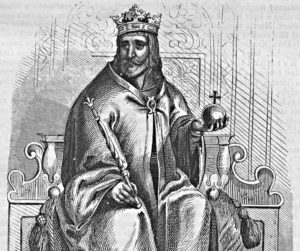
The Transylvanian governor Aloisio Gritti fled here in September 1534, but the Transylvanians invaded the town and on 29 September he was hanged and buried here. There lived 35 monks in the Franciscan convent in 1535. In the years following the Reformation, the monastery was used as a stable. The Guild of Swordmakers was founded in 1538.

In 1539, King Szapolyai János confirmed the free right of Medgyes merchants to buy and sell throughout Hungary. It was also the year when the guild of the masons was founded. The guilds of wheelwrights and locksmiths were formed in 1540. In 1541, there were about 57 shingle or thatched stone houses in the town.

The Franciscan friars of Cekes were expelled from the town by the Lutheran Saxons in 1543. In 1544, the number of monks in the monastery was reduced to 14. A synod of Transylvanian Saxon clergymen was convened in Medgyes, and they united in the Protestant religion in May 1545. The decisions taken here were confirmed by the meeting of the Saxon University in Sibiu on 28 November 1545. It was the Reformatio ecclesiarum Saxonicarum. You can read more about the Transylvanian Saxons on my page:
https://www.hungarianottomanwars.com/essays/who-were-the-german-saxons-in-transylvania/
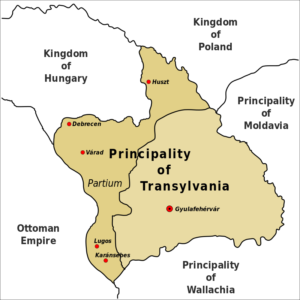
During the time of Bartolomaeus Altenberger, the first Protestant pastor, the former Roman Catholic St Margaret’s Church became the property of the Lutheran Evangelical community. At that time, the Roman Catholic altar and paintings of the church were removed. Altenberger was called to become a pastor in Nagyszeben (Sibiu) in 1547. The Lutherans held their synods in Medgyes in 1559, 1560, 1561, and 1572.
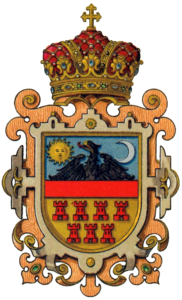
Thirty-two students from Medgyes enrolled in the upper classes of the Honterus Gymnasium in Brassó between 1549 and 1590. In 1550, Queen Isabella authorized the guild of leeches to operate in the town.
The tower of St. Margaret’s Church was raised between 1550 and 1551, adding five more floors to the three that had been there. The works were completed in just two months, resulting in a tower height of 68.5 m. The increased weight of the tower, which could not cope with the sandy soil, caused it to sink. The four wooden towers were then built on the four corners of the tower, thus announcing to the world that the city of Medgyes had the right to sentence people to death.

According to the sources, the leader of Medgyes was Simon Pellio in 1552. During the same years, the Austrian Emperor Ferdinand I and the King of Hungary made the town of Medgyes the permanent seat of the Two Seats and the office of the King’s magistrate.
A Diet was held again in Medgyes in August 1553. The Saxon Lutheran clergy elected their first bishop (superintendent), Paul Wiener (1553-1554). Later, when Lucas Unglerus (1572-1600), pastor of Berethalom was elected, the seat of the Lutheran bishop became Berethalom until 1867.

Plague broke out in and around Medgyes in 1556. Around 1556, the Transylvanian fraction of noblemen who supported the connections with the Ottomans expelled the monks from the town during the Reformation movement, took the church and the convent, and turned it into a hospital. The lepers’ hospital was first mentioned in 1557 in Medgyes.

Under the presidency of the Lutheran Bishop (superintendent) Hebler, the pastors of the church gathered for a synod in Medgyes between September 1559 and January 1560. Dávid Ferenc (around 1520 – 1579) and Heltai Gáspár (1510? – 1574?) took part in the synod, too. The synod was repeated in February 1561. This was the time of the accession to the Augsburg Confession of Faith and the establishment of the link with Germany. In 1564, the city suffered great destruction by fire.

The city was the scene of two Diets in February and December 1569. Laws were passed against the Unitarians.
Michael Weiss, the famous chief magistrate of Brassó, was born here on 13 January 1569.
Jan. 1-6, 1570 The nobles gathered again in the city for a Diet.
1570 The Guild of Butchers was founded.

1572 The Synod of Medgyes confirmed the adoption of the Augsburg Confession of Faith.
15-18 September 1573 The Diet of Medgyes authorized Báthory István (1571-1575) Voivode of Transylvania, (1575-1583) Prince of Transylvania to liquidate the party of Bekes Gáspár.
1574 Guilds of Fishermen and Bakers were formed.
1575 The town had 461 tax-paying households and 64 widows. A total of 2200 souls.

14 Jan. – 8 Feb. 1576 The Diet held in Medgyes confirmed the princedom of Báthory, who left his younger brother, Kristóf, as governor in Transylvania. On 28 January, Polish envoys in Medgyes invited Báthori István to the Polish throne. The ceremony took place in the Saxon Lutheran Church. István Báthory István confirmed Dávid Ferenc as the Unitarian bishop at the last Diet in Medgyes in 1576.
1577 Simon Pelio was the mayor of the town.
1579 The town paid 600 Forint taxes to the Turks.
1582 The Guilds of Barbers and Coppersmiths were formed.
25 February 1583 Báthory István, King of Poland and Prince of Transylvania confirmed the previous privileges of the guild of the barrel makers’ of Medgyes.
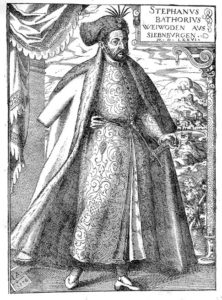
1583 Báthory István gave the settlement of Völc, Medgyesszék to the city of Medgyes. The revenues of the new domains were used to maintain and strengthen the walls of the town.
1584 Establishment of the Hatter’s Guild.
25. November 1585 Prince Báthory Zsigmond acted as arbitrator in the lawsuit brought by the barrel makers of Medgyes against the guilds of Segesvár, Steinhalm, and Szentágota. The latter won the case.
1585 The paid officials of Medgyes were: mayor, king’s judge, judge of the Seat, notary, 11 city senators, city architect, city prosecutor, and two treasurers.
1586 An epidemic of plague decimated the town and the surrounding area. The tax paid to the Turks rose to 696 Forint.

8 May 1586 Prince Báthory Zsigmond (1581-1597) allowed the Goldsmiths’ Guild of Medgyes to buy 2 Marks (480 grams) of gold from the princely treasury annually and use it for gilding silver objects.
1588 Bocskai István’s nephew, his ward, Báthory Zsigmond, was declared to have reached adulthood at the Diet of Medgyes (8-23 Dec 1588) and he took over the government. The Jesuits were expelled from Transylvania. Forty-seven houses in Új Street (Neugasse) were destroyed by fire. The Schuller House belonged to the town magistrate Hannes Schuller.
1589 The Guilds of Carpenters, Blacksmiths, and Potters were formed.

21-29 March 1599 The Diet of Medgyes elected Cardinal Báthory András as the successor of Prince Zsigmond. Until 1973, the event was commemorated by a marble plaque on the wall of the Schuller House on Hospital Street. In 1973, a lengthy restoration of the house was begun according to the plans of the architect Hermann Fabini, and the plaque was “temporarily” removed.
1601-1604 A plague decimated the population.
1601 Simon Kirtschner, pastor of Medgyes, kept a diary of events affecting his church, it was the “Diarium Ecclesiae Mediensis”
23-31 August 1602 The Diet of Medgyes raised its voice against Basta’s reign of terror.

1603 The army of Prince Székely Mózes (May-July 1603) caused great destruction in the town.
1604 The Saxon school has its registers from this year, and the register of rectors is complete. The rector of the school at this time was Matheas Schullerus, who received a salary of 60 Forints from the town treasury.
1605 The troops of Bocskai István (1605-1606) ruled the city.
27 August 1605: the solemn entry of Bocskai István into Medgyes. On the occasion of the Diet convened in Medgyes on 4 September, the representatives of the three nations greeted Bocskai with the “same heart and soul” in his princely office and confirmed Bocskai as the head of Transylvania. On 14 November 1605, Bocskai swore to uphold the constitution of Transylvania at the next Diet there. He received the princely insignia from the Sultan’s envoys. Let us note, that until 14 September, the Saxons had opposed Bocskai’s election as a prince.

1607 Simon Zacharias was town consul, Joannes Krugh was chair judge.
23. April 1608 Segesvár had a great flood that had never been experienced before, and Medgyes could not escape the disaster, either.
1608 Mason Joannes is elected senator of the city. Joannes Jarus and Laurentius Bernadinus were elected to replace the deceased town notaries Martinus Horwatth and Joannes Maurer.
1609 Staphanus Sartor (master tailor) was appointed as chair judge, Petrus Kolosvári as town clerk.
29 September – 4 October 1610 Diet in Medgyes

1611 Count Forgách Zsigmond, the imperial commander, occupied the town, and soon Báthory Gábor, Prince of Transylvania, conquered Medgyes with 300 soldiers. He demanded 12,000 Hungarian Forints from the city. The king’s magistrate of Medgyes was Blasius Pellio (master of the Skinners’ Guild)
23. February – 16. March 1614 The Transylvanian Diet was held in Medgyes. In the same year, a riot against the town’s mayor, Petrus Gotterbarmet, was recorded. During the Diet, in March, on March 5, the assassins of Prince Báthory Gábor, namely Szilasi János and Ladányi Gergely, were captured and executed there.
1615 Medgyes had 225 taxpayers. At that time the town was divided into four tax districts, these were: Minus (Small), Majus (Large), Zekesch, and Kő Street.
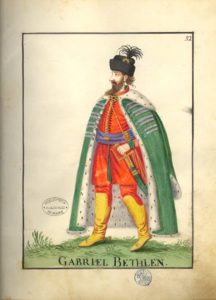
1615. February 10. A charter of Prince Bethlen Gábor in the castle of Fogaras confirms the rights of the Carpenters’ Guild.
1616 The first mention of the town’s Council House (Városháza). According to the account book of the town of Medgyes, the hospitality of Prince Bethlen Gábor and his court cost the town 260.86 Forints in gold. In Bethlen’s time, 1 gold Forint weighed 3.55 g of gold.
1618 The town of Medgyes bought the house of Körmendi János in Gyulafehérvár to accommodate the delegation of the prince’s court.
1621 From this year, we know the rules of the leaders of the town council, the council of hundreds, the magistrate, and the town council. According to these regulations, the citizens of the city were forbidden, under heavy penalty, to sell their houses, plots of land, and farmland to other nationalities. Further restrictions were imposed in 1683, and the offenders were expelled from the town after shaming and ridiculing them.
7 April 1621 Under the pastor Simon Kirtscher the old pipes of the Lutheran church organ were replaced with new ones.
1624 The Guild of Broad-cloth makers was founded.
11 October 1624 Prince Bethlen Gábor (1580-1629) ordered two gilded silver pots from the Medgyes Goldsmith’s Guild. The prince noted that he wanted the finished goods for St. Martin’s Day (11 November), and therefore urgently, as he was preparing for his wedding, the two pots would decorate the wedding table. He added that the weight of the gilded jugs should be 3380 grams and that he would pay for the work on time.

4 December 1625 Another order arrived from the princely seat of Gyulafehérvár. Prince Bethlen asked for 12 silver plates.
19 March 1627 The town gave Michael Wimmerden, the town trumpeter, a new trombone and four trumpets.
1629 A bridge was built over the Nagy-Küküllő. Martinus Hifft, a member of the Medgyes Tailors’ Guild, compiled a “sample booklet”, the ancestor of today’s advertising booklets. In it, he collected patterns, dress patterns, and samples of the fabrics available to them.
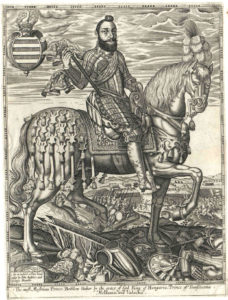
1630 Diet of Transylvania in Medgyes. Petrus Aurifaber is the king’s judge.
1631 Construction of the gate tower (Zekeschtor) on Cekes Street (it stood on the corner of Cekes and Kutya Streets)
1632 Construction of the Schmiedgässer Gate, it was the gate bastion of the Smith Guild (opposite the Hospital)
1633 Plague outbreak in Medgyes, 800 people died, 9-14 burials per day.

23 September 1633 Johannes Reisner confirmed that Merten Goldschmiednek and Paulus Weyrauch of the Medgyes Guild of Honourable Goldsmiths received 12 marks of silver (2 kg 880 grams) from Prince Rákóczi György I (1630-1648) and made 4 vessels from it. The same Johannes Reisner, dated 16 October 1633, confirms that the Medgyes goldsmiths made and sent two pairs of chalices weighing 1 kg 400 grams, which the prince had ordered for the Turkish Porte.

9 August 1634 According to the town’s account book, 222 gold Forints, and 46 denarii were spent on the purchase of arms, gunpowder, and lead. This large sum was contributed by the guilds of the town. To give an idea of the size of the sum, 1 Forint of gold would have bought 6 buckets = 67 liters of wine between 1600 and 1640. At 1634 prices, 222 Forints and 46 denarii would have bought 14 904 liters of wine.
1635 The tower gate at Farkas Street (Forkeschgässer Tor) was rebuilt and took its present form. A small gate for the entrance of persons and a guardhouse for the gate’s guard was built. The latter was used as a baking house in peacetime. This year the grape harvest was very poor.
1636 Construction of the gate tower at Kő Street (Steingässer Tor) began, the building’s predecessor was mentioned in 1507. The building was 28.50 m high. It was severely damaged by Pekry Lőrinc’s Kuruc troops in 1705 and rebuilt in 1743.
1637 March 1-22 Transylvanian Diet in Medgyes. This year, the rector of the German school, Matthias Miles, introduced new school regulations. The school was upgraded to a high school.
1639 A wooden bridge was built in the area of the present-day Küküllő bridge.
12 June 1640 Meeting of the Union of the Beltmakers’ Guilds in Medgyes. This year the Medgyes Guild of Strapmakers was founded. 1641 The Saxon Lutheran grammar school acquired a rail iron from Torockó.
1642 Twenty-eight guilds were registered in Medgyes.
1643 The Carpenters’ Guild was founded. A plague epidemic in and around Medgyes.
1645 Completion of the construction of the Kő Street gate.
1646 Plague epidemic in Medgyes, according to records, again with 800 victims. Further years of epidemics: 1653, 1656-1658, 1660-1661.
3 September 1653 The hospitality of the Turkish delegation led by Kapucsi Pasha cost 91,13 gold Forints at the expense of the town. 1657 The Guild of Knifemakers was founded. Formulation of a strict code of conduct for the Medgyes Guild of Knife Craftsmen.
22 January 1658 The Transylvanian Diet in Medgyes, during the siege of Prince Barcsai Ákos.

12 December 1659 A Diet was convened in Medgyes.
1660 The first rules of grammar school were issued, they date back to the rector Mathias Milles. In the upper classes, Greek and Latin, religion, logic, rhetoric, poetics, and singing were taught. The pupils attended morning and evening prayers. The town clerk was Stephanus Tatarlaki.
1661 The Medgyes printing house began operations.
2 June 1661 The Transylvanian Diet held here declared secession from the Turks.
1662 For the first time a Jewish taxpayer was mentioned in the town.
20 October 1662 Transylvanian Diet in Medgyes. The oldest book inventory of the library of the Lutheran school.

1671 There was a report of burning water in Felső Bajom (Basna). Georg Wette, a pharmacist from Nagyszeben, wrote a paper about it in 1688, its title was “De Aquis ardendibus”. The first mention of natural gas in Transylvania.
1672 Outbreak of plague in and around Medgyes.
1673 The Senate of the town of Medgyes hired a postmaster for one year in the person of Domokos István (Magister Postarum) Domokos’ salary was 90 gold Forints a year, plus allowances of food. He had the right to employ two men and to keep two carriages. The senators of the town this year were Mathias Bernhardi, Martinus Wellmanus, Georgius Kirschner, Petrus Binderus, Valentinus Seraphinus, Michael Kessler, Stephanus Hann Villicus, Mathias Tinnes, Georgius Axmann, Stephanus Graeser, Johannes Schneider, Michael Stamp alias Buser. The judge of the Seat was Mathias Czekescher.
1675 In the town 461 taxpayers and 64 widows were registered.

1676 The consumption of wine in Medgyes by Prince Apafi Mihály and his entourage cost the town 155 gold Forints. The town paid taxes to the Turks after 224 households.
1679 Senators of the city of Medgyes: Joannes Auner Proconsul, Stephanus Hann, Mathias Tinnes, Georgius Axman, Joannes Schneider, Michael Satmpius, Georgius Goldschmidt, Joannes Weinhold, Petrus Hermann villicus, Michael Krauss, Andreas Mollitoris, Martinus Hoffmann.

30 April 1683 The election resulted in Michael Kessler being elected as Judge of the King and Seat Judge.
1686 A student theatre called Schüler Teatro was established in the Medgyes Gymnasium (high school).
1688 The town hall is badly damaged by a summer thunderstorm. Due to a lack of time and money, it took six years to repair the damage. In April of that year, the number of taxable households was reduced to 200.
1691 Rebuilding of the city walls around the present hospital, reinforcement of the bastion near the Farkas Street gate tower.

6 December 1691 A company of General Veterani’s Regiment of the Austrian Imperial Army was quartered for wintering in the settlements of Medgyes, Berethalom, Válhíd, Muzsna, Baromlaka, and Kisselyk.
1692 Part of the Lutheran school building was rebuilt. A watchmaker is employed to maintain and adjust the church clock tower. His annual remuneration was 45,84 gold Forints. Here the town also employed a trumpeter, whose job was to signal emergencies (fire, flood, enemy in sight). He also signaled the arrival of the Transylvanian prince or high-ranking officials. His salary was 40 gold Forints a year in cash, grain, bacon, and firewood in kind.

1694 November 23. The Diet of Marosvásárhely (Târgu Mures) established the number of Medgyes’ taxable households at 110.
1695 The Guild of Soap-makers was founded.
1698 The number of guilds operating in the town was 33. At that time, 51 households (220 inhabitants) kept 6 oxen, 96 households (340 inhabitants) 4 oxen, 176 households (516 inhabitants) 2 oxen, and 176 families (674 inhabitants) were without draught animals. There were also 150 apprentices, servants, field guards, and 130 poor. The total number of inhabitants is 2030.
26 Jan 1699 The town hospital was established in the former Franciscan monastery. Transylvania was occupied by the Habsburg Empire under the Treaty of Karlóca.
1699 The number of taxpayers this year was 417.

7 April – 13 June 1705 The armies of the Kuruc general Forgách Simon, Count of Forgách and Ghimes besieged the walls of Medgyes for 10 weeks, then took the city. With the retreat of the Kuruc troops, the city fell into Austrian hands. Baron Görtz commanded the Imperial troops. He made his headquarters here after the evacuation of the Lutheran parish. He imposed a war fine of 8,000 gold Forints on the town.
1 November 1705 An inventory was made of the weapons made for the troops of Prince Rákóczi Ferenc II.

27 October 1706 A Transylvanian Diet was convened in Medgyes. Rákóczi visited Transylvania for the first time as an elected prince. At the Diet of Medgyes, he tried to introduce in Transylvania the economic measures that were already in force in Hungary: copper money, and a tax to cover the costs of the war.
1709 In June and the following months, the plague devastated most of the population in Medgyes, Segesvár, as well as in Küküllő and Torda counties, like in Udvarhely and Gyergyószék. It was the year of the formation of the Button makers’ Guild.

1711 The town had a paid postmaster, he was under the command of the town magistrate. In the town’s payroll, we also find the schoolmaster (the schoolmaster is mentioned in 1611, 1615, 1675, and subsequent years), the school and church servant, and in the list, we find two more soldiers from Szék.
14 November – 20 December 1712 At the Diet of Medgyes, the Transylvanian noble estates took the oath of allegiance to Charles III (1712-1740) as King of Hungary and Prince of Transylvania.
24 February – 25 June 1713 The long-running Diet was held alternately in Medgyes and Nagyszeben. Over the years, 21 Transylvanian Diets were held in Medgyes (1459, 1553, twice in 1569, 1570, 1573, 1576, 1588, 1599, 1602, 1605, 1610, 1614, 1630, 1637, 1658, 1659, 1662, 1706, 1712, 1713)

1713 A school building was erected on the north side of the fortified church.
1717-1718 Plague decimated the population, this time with 770 victims. The great heat caused an extensive famine and a bushel of grain cost 4 Forints.
1719 The Guild of Tassel makers was founded.
1 March 1720 The town council fulfilled the will of the Austrian general Count Anton Virmond Hugó Damian (1666-1722): the Franciscans were allowed to return to the crumbling church and convent in Cekes. Most of the ruined church building was later rebuilt in the Baroque style.
In 1722, a Roman Catholic elementary school was founded, operating with minor interruptions until 1948.
1723 There were 352 craftsmen living in Medgyes. Their income amounted to 19,449 Forints a year. (For comparison, the price of a pair of oxen was 55 Forints at that time.) Their products were sold at lively weekly and national fairs. In 1723, the number of tax-exempt persons (exemptus) in Medgyes was 101. Among them were the town magistrate (dux), notary 1, organist 1, horn player 1, town Hajdu soldier, and servant 22, town cook 1, watchmaker 1, piper 1, town coachman 1, courier 3, shepherd 5, the rest were either newcomers or newly married.

1723 October 5 The Strap-making Guild of Brassó sent a letter to the Medgyes guild asking them to give them first place at the coming Medgyes fair, and they added to the request by asking them to exclude the Szeben guild from the fair.
1725 During the regency of Atanaz Melsing, the first major construction and restoration of the Franciscan monastery began, the renovation of the north wing floor at the expense of Princess Maria Anna Lichtenstein.
1726-1733 The eastern wing of the Franciscan monastery, built in the Gothic style in the 15th century, was extended by the western and northern wings.
1728 The Franciscan church of Medgyes was rebuilt in Baroque style. The entrance, the choir, and the sacristy are evidence of its former Gothic style.
1731 Repairs were begun to the eastern wing of the Franciscan monastery, the wing facing the Küküllő river.
1732 According to a record by Daniel Conrad von Heydendorf, the organ of the Lutheran church was renovated during Lent. The organ builder was paid 85 Hungarian Forints and the painting was done for 30 Forints.
1735 The Franciscan monastery was inhabited by 35 monks.

1736 A large part of the brick wall surrounding the town was 2400 m long, 8 m high, and 80 cm thick. It had 3 strong gate towers, 4 pedestrian gates, 19 gates, and a bastion. To facilitate the expansion of the city, one gate, three small gates, and 12 bastions were demolished.
Around 1740, with the generous support of Governor Haller János and his wife Daniel Zsófia, the nave of the Roman Catholic church and the south side chapel were restored.
1741 Restoration of the south wing of the Franciscan monastery. The Piarists founded a school in Medgyes with the support of the Transylvanian Treasury, but this was not viable due to the hostility of the Saxon population and the small number of pupils. It was closed in 1789, and the building on the west side of the Main Square was bought by a merchant called F.I. Guggenberg in 1794.
1745 The Kő Street gate tower was rebuilt.

1747 The Franciscan monastery of Medgyes was elevated to the rank of a convent, and from then on it became the home of the order’s higher school. Within its walls, there was also an elementary school.
1752 January 8 The Evangelical Church Council of Medgyes decided on the church meeting schedule. The guilds were assigned seats according to their importance, authority, and economic status.
1753 The last witch trial in Medgyes.

1754 The Royal Table – the highest legislative body in Transylvania – was moved from Medgyes to Marosvásárhely by Empress Maria Theresa.
2 June 1759 Evangelical pastor Georg J. Haner communicated the new seating plan of the church to the brass guild.
1760 The Black Eagle Apothecary (Apotheke zum Schwarzen Adler) opened in the Schuller House
1763 The grape harvest was abundant and good in the Küküllő region, just like the fruit harvest.
8 April 1765 Master weaver Johann Schuster complained to the town magistrate. He listed that he had bought Martinus Gräff’s seat in the church in 1746, but that this place had been sold to a rope weaver’s guild in the confusion of the rebuilding of the organ. He reclaimed his seat.

1766-1769 Dugonics András taught poetry and rhetoric at the Piarist grammar school in Medgyes. He is the author of the first Hungarian novel, Etelka.
1766 Empress Maria Theresa decreed the abolition of witch trials.
16 January 1768 The town council sentenced Csáky György, master locksmith, to 10 Forints for contraband and obliged him to practice his trade as a member of the guild.
Around 1770 the Roman Catholic church was decorated with 8 altars.
1771 July 13-24 A great flood devastated the lower town.
1771 November 16 The town council of Medgyes relinquished the ownership of the monastery and convent in Cekes.
1771-1781 The printing house of Johann Sifft was in operation.
1773 The main altar of the Roman Catholic church was replaced by a more ornate and larger altar.

2 June 1773 Archduke Joseph, later Emperor Joseph II, visited Medgyes in an open carriage.
4 July 1781 Joseph II (1780-1790) signed the so-called Concivilitas decree, according to which Medgyes (the parts within the castle wall) were allowed to be inhabited by Hungarians and Romanians in addition to the Saxons. This is the beginning of the ethnic coloring of Medgyes, the hegemony of the Saxons became a thing of the past. It was the time when the town lost its pure Saxon character. Emperor Joseph aimed to depopulate the town, to create a ‘natio austriaca’, and to this end, Austrian, especially Moravian, officials and military officers, most of them of the Catholic faith, was stationed there.

Source: Historical chronology of Medgyes, Compiled by Szabó M. Attila
My note: I have just one family recollection about Medgyes: my father-in-law’s family used to live in Medgyes but he and his family were expelled from there in the early 1940s. They were Hungarians (with Saxon roots?), and they were given an hour to pack their things before their deportation to Hungary.
Dear Readers, I can only make this content available through small donations or by selling my books or T-shirts.
If you like my writings, please feel free to support me with a coffee here:
You can check out my books on Amazon or Draft2Digital, they are available in hardcover, paperback, or ebook:
https://www.amazon.com/dp/198020490X
or at https://books2read.com/b/boYd81


My work can also be followed and supported on Patreon: Become a Patron!http://Become a Patron!

[wpedon id=”9140″]














































